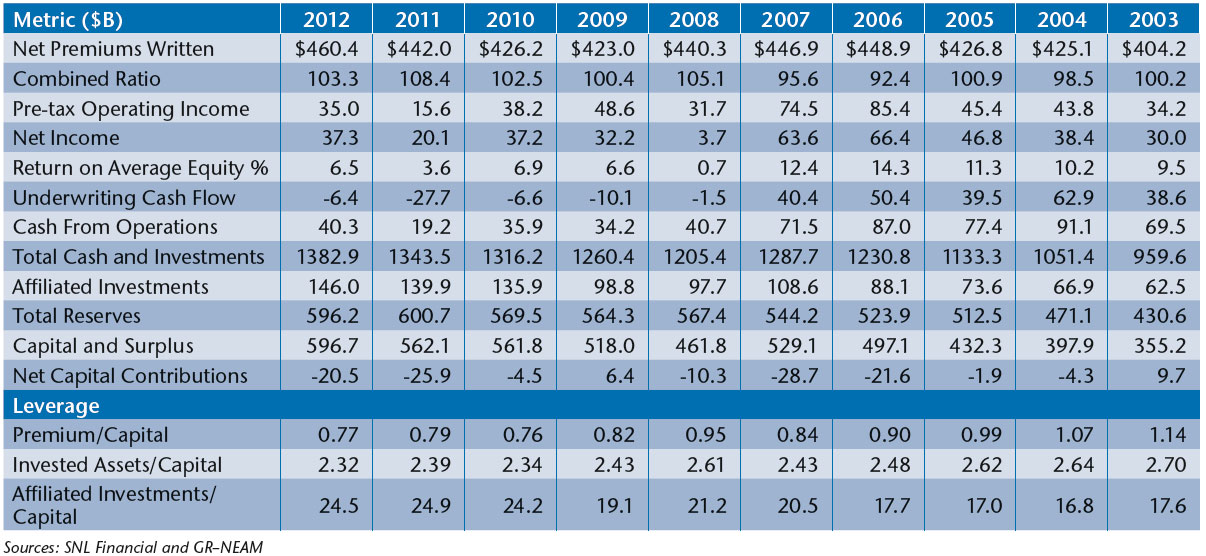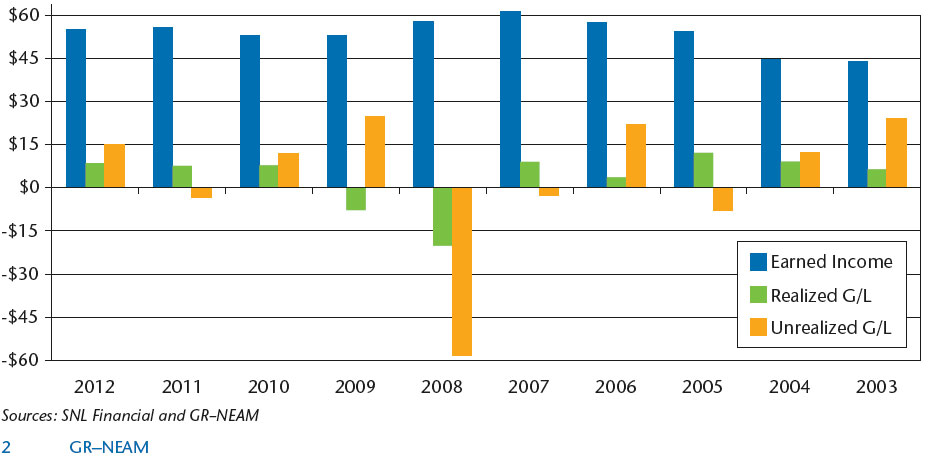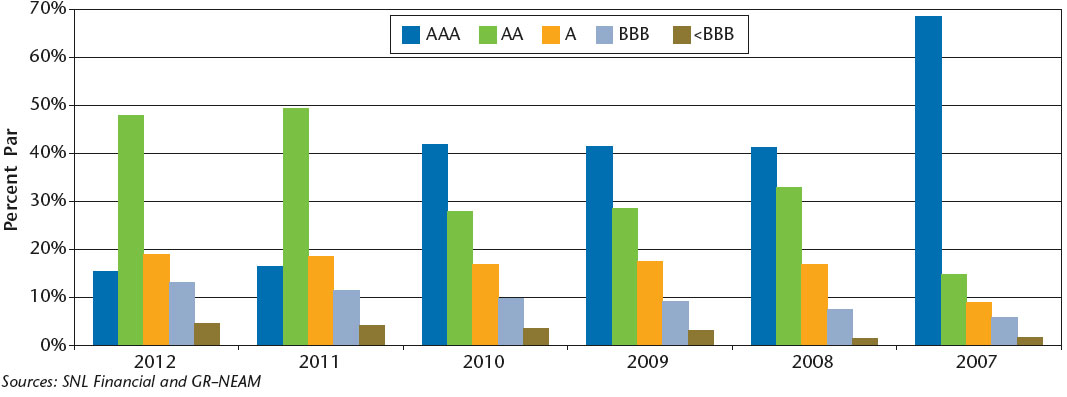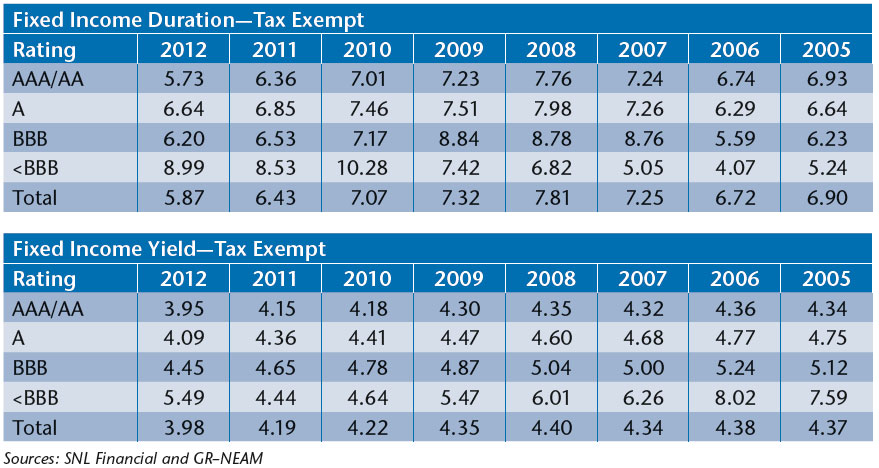Our focus in this General ReView is the U.S. property/casualty (P&C) industry. A companion piece will follow for the life insurance industry. In turn, for each industry segment we will provide additional General ReView issues to address industry subsegments, company variations, transactions summaries and prospective returns.
Our database encompasses a 10-year history of CUSIP holdings and their market statistics (durations, spreads, NRSO ratings, etc.) as of each year’s end since 2003. It cannot be replicated and we are unaware of it existing elsewhere. This enables GR–NEAM to provide greater in-depth investment results and portfolio analysis for clients than what is otherwise available.
The year 2012 proved to be difficult for industrywide operating results, a continuing theme since 2008.
Similarly, fixed income markets offered (near) record low yields as equity markets continued to rebound from their 2008–2009 collapse. Responses to this difficult environment varied among companies as they adjusted their investment portfolios to align with their unique underwriting profiles, current capital market opportunities and forward assessments of each.
Financial Statement Summary Results
Table 1 provides a 10-year history of select metrics for the P&C industry. Premium income increased $18 billion, or 4% over the prior year. The combined ratio declined but remained over 100 for the fifth straight year. Pre-tax operating income and net income recovered to their 2010 levels but well below the highs of 2006. Return on statutory surplus increased to 6.5%, resulting in a 10-year average after-tax return of 8.0%.
Table 1. P&C Industry Highlights ($ Billions Except Combined Ratio, Return on Equity and Leverage)

Underwriting cash flow improved but remained negative. Cash and invested assets increased modestly over the prior year. Total reserves declined slightly while capital and surplus increased 6% to nearly $597 billion, reflecting the improved underwriting results, continued equity securities’ gains and lower capital withdrawals. Premium and investment leverage, and the ratio of affiliated assets to surplus, remained essentially unchanged.
Chart 1 shows the composition of statutory investment results by their key components: earned investment income, realized gains/losses and change in unrealized gains/losses. Earned investment income declined slightly (1.4%) in 2012 to $54.9 billion. Realized gains of $8.6 billion combined with change in unrealized gains of $15.1 billion resulted in total pre-tax statutory investment returns of $78.6 billion, an increase of $18.5 billion from 2011.
Chart 1. Statutory Investment Results Before Taxes and Expenses ($ Billions)

Table 2 suggests that statutory allocations across broad classifications were essentially unchanged after allowing for equity market appreciation. And, similar to last year, “Other” asset ownership is very concentrated: one group owns 40% of the category while 10 companies own over 75%. Despite the recent focus on “alternative assets,” there remains a reluctance to expose statutory capital to their episodic returns.
Table 2. P&C Broad Sector Asset Allocation

Table 3 shows earned investment income by broad asset class. Total net of expense earned investment income decreased slightly ($800 million) from the prior year. Fixed income portfolio income decreased reflecting declining book yields. “Equities” and “All Other” sectors’ income increased slightly from the prior year. And again, the results of the latter category are concentrated among but a handful of companies.
Table 3. Earned Investment Income by Broad Asset Class ($ Billions) and Fixed Income Gross Book Yield

Portfolio Details
Table 4 displays fixed income sector allocations. This municipal category includes only tax-exempt bonds. The retrenchment in tax-exempts has been significant since 2008, led by several large organizations with weakened underwriting results. U.S. Government and Agency allocations were also reduced. Taxable municipal, non-dollar and private bonds are shown in the “Other” category. Totaling over $73 billion in 2012, their respective allocations are about equal. Corporate and non-dollar bonds allocations increased. Non-dollar and taxable municipal bonds have more than tripled since 2005 and almost doubled since 2009, albeit the ownership of the former category is extremely concentrated among five groups owning 60% of the total.
Table 4. Fixed Income Sector Allocation

Table 5 displays the option-adjusted duration (OAD) by fixed income sector. Total bond duration is unchanged. Taxable bond duration increased across all major categories. Municipal bond duration decreased over one-half of a year in 2012 from 2011 and nearly two years since 2008, following the years of peak underwriting profitability. The changes are due to a combination of maturity, sales and purchases. The OAD statistics are based upon CUSIP level Schedule D holdings of statutory filings only. They exclude any holding company bonds or derivatives.
Table 5. Fixed Income Sector Option-Adjusted Duration (OAD)

Municipal bonds remain the industry’s largest asset class. Table 6 shows that municipal bonds represented 50% to 75% of 62 companies’ bond portfolios in 2012. These same companies owned about 45.9% of the industry’s tax-exempt bonds and on average, they represented 60.9% of their fixed income holdings. Their numeric average and dollar-weighted OAD were 5.52 years and 5.79 years, respectively.
Table 6. 2012 Municipal Bond Holding Distribution

Table 7 displays book yield by fixed income sector. Across all sectors the aggregate decline was 34 basis points (bps). Taxable sectors led the decline (40 bps) with all sectors posting a reduction. The Tax-Exempt Municipal decline was 20 bps.
Taxable book yields have declined nearly 150 bps since their high in 2007; municipals decline, from their peak yields in 2008, has been 42 bps at a time when their OAD was two years greater. In large part, the reduction in municipal yields was “self-inflicted,” reflecting sales as much as purchases, as durations were shortened and gains were taken, for a variety of reasons. In 2012 municipal bonds gross book yield exceeded that of taxable bonds by over 20 bps.
Table 7. Fixed Income Sector Book Yield

Chart 2 displays fixed income credit quality. In 2008 fixed income credit quality showed widespread reduction of triple-A securities, reflecting corporate and structured securities downgrades. The 2011 reduction in triple-A securities reflects Standard & Poor’s downgrade of U.S. Government securities. In 2012 credit quality weakened as a consequence of purchases, not downgrades. This behavior commenced in 2011 and continued in 2012.
Chart 2. Fixed Income Credit Quality

Table 8 displays the OAD and book yield for taxable bonds by credit rating. Taxable bond durations increased for all investment grade rating categories except below investment grade in 2012. The amount of the increase was over three-tenths of a year. Taxable book yields declined across all rating categories, but most notably for below investment grade, for which the decline was over 85 bps. In prior periods below-investment grade yields were the most resistant to downward rate movements.
Table 8. 2012 Taxable Bond Duration and Book Yields by Rating Category

Table 8. 2012 Taxable Bond Duration and Book Yields by Rating Category (continued)

Municipal bond duration continued its steep descent from the 2008 high of 7.81 years to 5.87 years, nearly a full two-year drop in duration. Only the below-investment grade rating category was immune from the decline. Book yields also declined in 2012. The 20 bps decline, although only half the amount of taxable bonds, was the greatest annual change since 2005. Table 9 details the results.
Table 9. 2012 Tax Exempt Duration and Book Yields by Rating Category

Aggregating across broad asset classes and credit quality, we define “risk assets” as the sum of schedule D equities and below-investment grade bonds and schedule BA assets. Their sum is shown in Table 10 below. The gradual increases in “Risk Assets” as a percent of assets and surplus are driven by increases in schedule BA assets and below-investment grade schedule D bond. The former is highly concentrated among few companies, the latter less so.
Table 10. “Risk Assets” in $ Billions and as a Percent of Invested Assets and Capital & Surplus

Summary
Allocations to non-traditional assets remain low and highly concentrated. Equity allocations increased but only due to unrealized gains. Taxable fixed income allocations increased as municipal allocations declined. The municipal bond allocation is at its lowest level in recent history, driven by companies whose capacity for tax-exempt income has lessened, and reflecting weakened underwriting results. Book yields continue to decline as higher yielding securities have been sold (especially tax-exempts) and/or matured. The yield decline has been slowed by purchases of lesser-rated securities.
Of course, there is wide variation among companies. In future issues of General ReView, we will address these variations. We will focus on the impact of sector allocation, credit quality adjustments, the role of schedule BA assets and other “alternative” asset classes and duration management. Additionally, we will address issuer concentration, credit duration and prospective total returns.
We welcome your feedback and comments. If there are investment themes in particular you would like us to review, please contact us.









